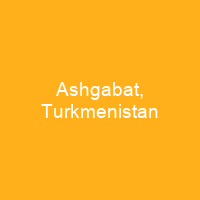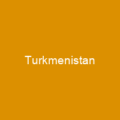Ashgabat is the capital and largest city of Turkmenistan. It is situated between the Karakum Desert and the Kopet Dag mountain range in Central Asia. The city was founded in 1881 on the basis of an Ahal Teke tribal village, and made the capital of the Turkmen Soviet Socialist Republic in 1924. Much of the city was destroyed by the 1948 Ashgabt earthquake but has since been extensively rebuilt.
About Ashgabat, Turkmenistan in brief

It has also been variously spelled Ashgabad andAshgabad. The Soviet-era Karakums Canal runs through the city, carrying waters from the Amu Darya from east to west. The population grew from 2,428 in 1879 to 19,428 by 1897. The main square of the town was named in honor of General Mikhail Sklevobe, a Russian military commander. The town was regarded as a pleasant municipality with European-style buildings, shops, hotels, and hotels. It may have been site of a Parthian fortress constructed to protect the capital city, Nisa, based on discoveries of pottery and other artifacts in the 1970s and as recently as 2020. The near suburb of Köşi, until 2013 a separate village but in that year annexed by AshGabat, may be site of an earlier city, Konjikala, first mentioned as a wine-producing village in the 2nd century BC and leveled by an earthquake in the 1st century BC. It survived as a small village until Russians took over in the 19th century. In the 20th century, it became a suburb of Nisa and was renamed Poltoratsk after a local revolutionary, Pavel GerasimovichPoltoratskiy. In 1925, it was renamed Aşgab at in Turkmen, in Russian from 1925 to 1991, and Ešq-ābād in Persian.
You want to know more about Ashgabat, Turkmenistan?
This page is based on the article Ashgabat, Turkmenistan published in Wikipedia (as of Dec. 30, 2020) and was automatically summarized using artificial intelligence.







